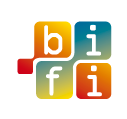Development Group.
Head of the Research Line:
Gonzalo Ruiz, gruiz@bifi.es
Researchers:
Alfredo Ferrer, aferrer@bifi.es
SUMMARY OF THE RESEARCH LINE
The development group belongs to the computing area at BIFI, and it is composed by two experienced computing engineers.
The main goal of this team is to research and support research when software development is involved. To achieve it, one of the most important tasks that we perform is the participation in research projects in which we collaborate with companies and other research groups. These collaborations are focused in different innovative topics such as, BigData, Internet analysis, social networks, distributed computing, new technologies in education, etc. The collaboration levels go from small contributions to local companies/research groups to international projects such as FPVII.
The other task that we carry out at BIFI is to support ongoing research through software development improving or optimizing programs that already exist, and consulting for choosing the best technologies and techniques for their development.
Relevant publications
1.- Analysis of academic productivity based on Complex Networks. September 2015, R. Álvarez, E. Cahué, J. Clemente-Gallardo, A. Ferrer, D. Íñiguez, X. Mellado, A. Rivero, G. Ruiz, F. Sanz, E. Serrano, A. Tarancón, Y. Vergara. Scientometrics, September 2015, Volume 104, Issue 3, pp 651-672.
2.- RRLab: Remote Reality Laboratory to teach mechanics in schools. November 2013, Elisa Cauhé, Alfredo Ferrer, Gonzalo Ruiz, David Íñiguez, Alfonso Tarancón. Chapter 6 of the book “IT Innovative Practices in Secondary Schools: Remote Experiments”, Published by Deusto in 2013. ISBN: 978-84-15772-01-9
3.- Hadoop Cloud SaaS access via WS-PGRADE adaptation. November 2012, Elisa Cauhé, Arturo Giner, Jaime Ibar, Gonzalo Ruiz, Ruben Vallés. 6th IBERIAN GRID INFRASTRUCTURE CONFERENCE PROCEEDINGS Pages: 161-172 Published: 2013
4.- Heterogeneous networks do not promote cooperation when humans play a Prisoner‘s Dilemma. 8th June 2012, Carlos Gracia-Lázaro, Alfredo Ferrer, Gonzalo Ruiz, Alfonso Tarancón, José A. Cuesta, Angel Sánchez, and Yamir Moreno. PNAS, Vol. 109, no. 32.
5.- OptiWeb: An optimization application for steel cut industries ported to the Grid in the framework of PireGrid project. 5th May 2011, “Proceedings of the 5th IBERGRID. ISBN: 978-84-9745-884-9”
6.- Structural and Dynamical Patterns on Online Social Networks: The Spanish May 15th Movement as a Case Study. 30th July 2011, Javier Borge-Holthoefer, Alejandro Rivero, Íñigo García, Elisa Cauhé, Alfredo Ferrer, Darío Ferrer, David Francos, David Íñiguez, María Pilar Pérez, Gonzalo Ruiz, Francisco Sanz, Fermín Serrano, Cristina Viñas, Alfonso Tarancón, Yamir Moreno . PLoS ONE 6(8): e23883, 2011.
Main research projects
1.- We participated in the project called “Aragón Open Data”, developing the “Social” part, that consists of gathering information from the Internet (social networks, press, etc.) related to Aragon and presenting it in a structured format through an API in order to provide citizens tools to make their own applications.
2.- Development of the application called Kampal which is a tool that builds and studies the networks formed by members of the University of Zaragoza through its research equipment and projects. The emphasis is on the relationships between people, in the dynamics of the interaction rather than individual properties.

3.- Development of a platform that includes several interactive teaching units focused in the studio of the Solar System using gestures thanks to the Microsoft Kinect device. These units have been developed in collaboration with the local school Juan de Lanuza within the context of its innovation cathedra.
4.- Participation in SEPS, an INNPACTO project which will try to forecast different kinds of possible risks and hazzards in electrical networks, and study the impact they would have if the finally happen. In this project we collaborate with companies and research organisms such as Gas Natural Fenosa, Telvent, Universidad Carlos III and Universidad de Lérida.
5.- RRLab (Augmented reality lab for physics): this project, also thought with educational purposes, consists of the creation of a web platform for the remote realization of some simple physics experiments with the aim that pupils were able to compare their theoretical results with the real ones.

6.- Prisoners dilemma experiment: we developed a web platform for the realization of remote collective experiments for the study of the behavior of people depending on the structure of their organization. This platform has been used for carrying out two different experiments for the moment, and in one of them 1300 pupils participated in real time. During the last years we have made several changes and improvements in the platform in order to study different parameters and variables and how they affect to the people behavior.

7.- Feelicity: it was a project based on Streetrs, developed with TEDxZaragoza people for the geotagging of happy moments of users.

8.- Collaboration in the Ibercivis project carrying out different development tasks (visualization, web development, BOINC client customization, etc.)

9.- Participation in the project called STEREA “Optimización de Recursos Hídricos y Telegestión de Regadío” that consisted of one of the first web applications made to manage the irrigation systems of different fields with the aim of optimizing resources, reducing costs and increasing the productivity.
10.- The FPVII project called SCIBUS, that aims to create a generic-purpose gateway technology as a toolset to provide seamless access to major computing, data and networking infrastructures and services in Europe including clusters, supercomputers, grids, desktop grids, academic and commercial clouds.
11.- Study of the Spanish 15M movement in the Twitter social network: in this case, the group supported different tasks related to the study such as the visualization, the creation of a web for its dissemination, the data collection, etc.

12.- Optiweb: in the beginning of 2011, this project made in collaboration with the company Schnell Software that consisted of the optimization of one of their software products for using a grid computing platform in order to improve its performance.








